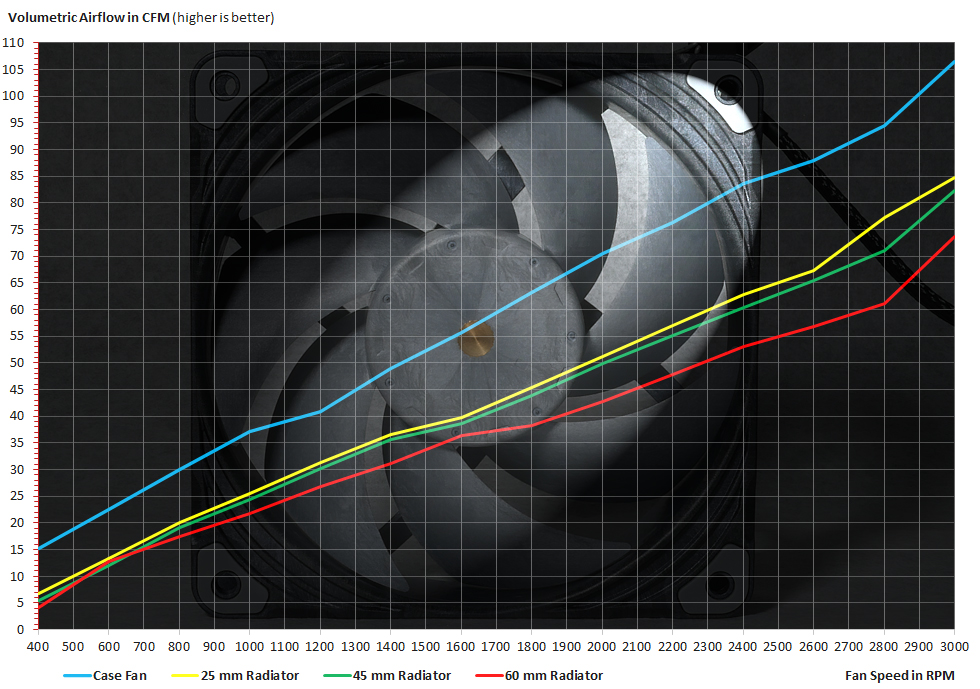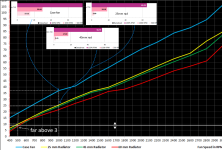1. We have a calibrated measuring camera and do not measure with a tube as others do the measurement with a chamber is much more accurate than with a tube we also do prototype tests for various manufacturers with this chamber.
2. What do you need more than 3 measuring points for?
Do you need more than minimum, middle and maximum points to compare fans?
We have already changed our test for each RPM.
3.Don't understand the question, it is a normal mathematical calculation.
4.
3000 RPM does not necessarily mean that the fan is louder than 2000 RPM. This has many factors to do with fan geometry, frame motor and much more.
And a measurement is something different than feeling the noise yourself.
By the way, Phanteks has checked us and we are exactly the same with all the values they have measured.
Our fan tests are internationally respected and have the reputation of having +-2-5% deviations.
What others measure I can not judge, but we measure not with a cheap tube but a calibrated chamber with calibrated measuring device and is regularly recalibrated for a lot of money.
OK.
as for:
1. Sure - this might the case. But still it's bit weird that all other reviews have different results. Cheap does not mean NOT accurate. And even in cheap setup if those values are not correct vs reality - it still should be valid as A to B comparison - noctua vs phanteks. It's strange - that's all I want to say.
2.Why? Because first of all it's not 3 - it's only 3. As third one - max RPM is not comparable as it's not the same RPM for both fans. And difference is vast. Also many people will use them @1250 and 1500RPM in reality as those levels are still very silent offering better performance.
And 2000 RPM that is max for Noctua could be easily recreated on Phanteks. So at the end this gives us comparison in lower 50% of speed range that could be compared between two fans. Honestly from scientific point of view - 2 data points covering 33% of one fan range and 50% of other fan range is useless. For me in general RPM vs Flow is useless - only thing that makes any sense is noise normalized test. As no one cares what RPM their fan does as long they don't hear it. But still - if you decide to measure this way RPM/Flow - you need to give more than 2 data points in low range only....
3. Let me explain what I mean:
On page 4 case fan comparison:
500RPM
Notua = 16.77 CFM
T30 = 15.12 CFM
Now in the same range on page 7 (conclusion)
@500RPM both fans are close to 10 CFM with noctua around 9 CFM and Phanteks somewhere 11 CFM. So not only the data in not in the same range also on page 4 bar graph Noctua takes the lead and on page 7 Phanteks has more CFM.
So this graph on page 7 does not represent Case Fan scenario maybe. What scenario is it?
If I'll take first radiator test (25mm) @500 RPM
Noctua = 6.95CFM
Phanteks = 3 CFM
Again not the same order of values as it's much lower than 10 CFM from page 7 CFM/RPM chart.
Also again Noctua doubles the flow of Phanteks on page 25mm radiator but situation is reversed on page 7 for 500RPM.
I thought it's maybe average of two - case fan and radiator scenario ? But again it will not explain lean of Noctua on page 4 and lead of Phanteks on page 7 chart.
Do you see what I mean? Page 4 charts and CFM/RPM chart show the same analysis but data is contradictory.
Are you sure there was no mistake in data acquisition or while creating the graphs - as it does not make any sense.
Now point 4.
I do not care what quality of equipment do you have and what is your sample size. I have 6 phanteks T30 for my main rig and and 8 noctua in A25 in my homelab server.
Noctua at 2000RPM is way way quieter than Phanteks T30 at 3000RPM. The difference is so vast that I don't need any equipment to state that.
My main rig with 3 Phanteks at 3000RPM sounds like a jet compared to my server with 8 Noctuas @ 2000RPM.
Also if it was confirmed by Phanteks how it is that in their own spec they say T30 @ 2000RPM is at 27.3dBA and at 3000RPM is at 39.7 dBA.
That is +45% more noise level from 2000 to 3000 RPM.
When in your chart on page 7 Phanteks @2000 RPM is measured @ 41.5 dBA and at 3000 RPM is @ 46 dBA.
That is +11% more noise level from 2000 to 3000 RPM.
Honestly I don't care how expensive is your equipment and how scientific are your methods. If I see white and someone is calling it black - I call bs -no matter what science you will use to pro try to prove it. Phanteks at 3000 RPM is WAY WAY lauder than at 2000 RPM. And for sure it's not the same noise level as Noctua at 2000RPM as your data shows.
And I don't buy this whole :
By the way, Phanteks has checked us and we are exactly the same with all the values they have measured
If that would be the case in their official specs we would not see 45% increase in noise level between 2000 and 3000 RPM.
There was some error made, maybe wrong column in excel, faulty equipment or bad calibration... But this noise thing is totally wrong.
Sorry foe lengthy post. But since I have great respect for Igor's Lab - I feel obliged to point out if something is wrong.
Please take a look at it. I think there is some mistake here.
Cheers!


